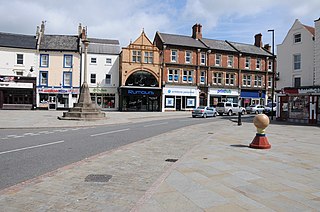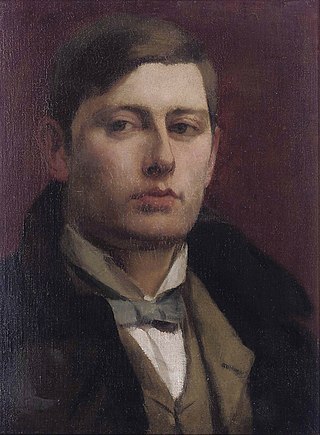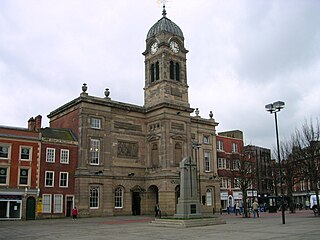
The Eleanor crosses were a series of twelve tall and lavishly decorated stone monuments topped with crosses erected in a line down part of the east of England. King Edward I had them built between 1291 and about 1295 in memory of his beloved wife Eleanor of Castile. The King and Queen had been married for 36 years and she stayed by the King’s side through his many travels. While on a royal progress, she died in the East Midlands in November 1290, while suffering from a strain of malaria.. The crosses, erected in her memory, marked the nightly resting-places along the route taken when her body was transported to Westminster Abbey near London.

Woolsthorpe Manor in Woolsthorpe-by-Colsterworth, near Grantham, Lincolnshire, England, is the birthplace and was the family home of Sir Isaac Newton. He was born there on 4 January 1643. At that time, it was a yeoman's farmstead, principally rearing sheep.

Grantham is a market town in the South Kesteven district of Lincolnshire, England, situated on the banks of the River Witham and bounded to the west by the A1 road. It lies some 23 miles (37 km) south of Lincoln and 22 miles (35 km) east of Nottingham. The population in 2016 was put at 44,580. The town is the largest settlement and the administrative centre of South Kesteven District.

Edward Colston was an English merchant, slave trader, philanthropist, and Tory Member of Parliament.

Grantham and Stamford is a constituency in Lincolnshire represented in the House of Commons of the UK Parliament since 2019 by Gareth Davies, a Conservative.

Sir George James Frampton, was a British sculptor. He was a leading member of the New Sculpture movement in his early career when he created sculptures with elements of Art Nouveau and Symbolism, often combining various materials such as marble and bronze in a single piece. While his later works were more traditional in style, Frampton had a prolific career in which he created many notable public monuments, including several statues of Queen Victoria and later, after World War I, a number of war memorials. These included the Edith Cavell Memorial in London, which, along with the Peter Pan statue in Kensington Gardens are possibly Frampton's best known works.

Portsmouth Guildhall is a multi-use building in the centre of Portsmouth, Hampshire, England. It is located in a pedestrian square close to Portsmouth and Southsea railway station. Constructed in 1890, the building was known as Portsmouth Town Hall until 1926. It was heavily damaged by bombing during the Second World War and largely rebuilt during the 1950s by the English architect Ernest Berry Webber. It now operates as a concert, wedding and conference venue. It is a Grade II listed building.

Colsterworth is a village and civil parish in the South Kesteven district of Lincolnshire, England, less than half a mile (0.8 km) west of the A1, about 7 miles (11 km) south of Grantham, and 12 miles (19 km) north-west of Stamford. The village with the hamlet of Woolsthorpe-by-Colsterworth had a recorded population of 1,713 at the time of the 2011 census, in an area of 1,465 hectares.

Northampton Guildhall is a municipal building in St Giles' Square in Northampton, England. It is a Grade II* listed building.

The Guildhall is a building on Alfred Gelder Street in the City of Kingston upon Hull, East Riding of Yorkshire, England. The building is currently the headquarters of Hull City Council but is also used as a venue for conferences, civic receptions and formal dinners. It is a Grade II* listed building status.

Grantham Museum is located at St Peter's Hill, Grantham, Lincolnshire, England, in the building provided for it in 1926.

Edith Smith was the first female police officer in the United Kingdom with full power of arrest.

Harrowby is a hamlet in the South Kesteven district of Lincolnshire, England. It lies 2 miles (3 km) east of the market town of Grantham. Harrowby was a hamlet in two parts: Harrowby Within, and Harrowby Without, which includes Harrowby Hall.

Christopher Turnor MP, JP, DL, was an English Conservative Party politician who sat in the House of Commons from 1841 to 1847, and a promoter of Lincolnshire architecture.

Sir Michael Newton, 4th Baronet, was an English landowner and politician who sat in the House of Commons from 1722 to 1743.

Leamington Spa Town Hall is a Grade II listed municipal building located in the town of Leamington Spa in Warwickshire, England. It is the meeting place of Royal Leamington Spa Town Council.

Derby Guildhall is a municipal building in the Market Place, Derby, England. It is a Grade II listed building.

The City of Portsmouth War Memorial, also referred to as the Guildhall Square War Memorial, is a First World War memorial in Guildhall Square in the centre of Portsmouth, Hampshire, on the south coast of England. Portsmouth was and remains a port and home to a major naval dockyard. The dockyard and the armed forces provided much of the employment in the area in the early 20th century. As such, the town suffered significant losses in the First World War. Planning for a war memorial began shortly after the end of the conflict and a committee was established for the purpose. It selected a site adjacent to a railway embankment close to the Town Hall and chose the architects James Gibson and Walter Gordon, with sculptural elements by Charles Sargeant Jagger, from an open competition.
A statue of Margaret Thatcher stands in her birthplace, the town of Grantham in Lincolnshire, England. The statue is 10 feet 6 inches (3.2 m) high, cast in bronze, and depicts the late British prime minister Baroness Thatcher, dressed in the full ceremonial robes of the House of Lords. It stands on a 10-foot-6-inch (3.2 m) plinth. Created by sculptor Douglas Jennings, and costing £300,000, it was erected on 15 May 2022, on St Peter's Hill Green, close to the Grantham Museum. Eggs were thrown at the statue within two hours of its installation, and a week later red paint was thrown at it. It was formally unveiled on 31 May.

Boston Sessions House is a judicial structure in Church Close, Boston, Lincolnshire, England. The structure, which used to be the main courthouse for the north of Parts of Holland, is a Grade II* listed building. The site is also home to County Hall, the former headquarters of Holland County Council.





















